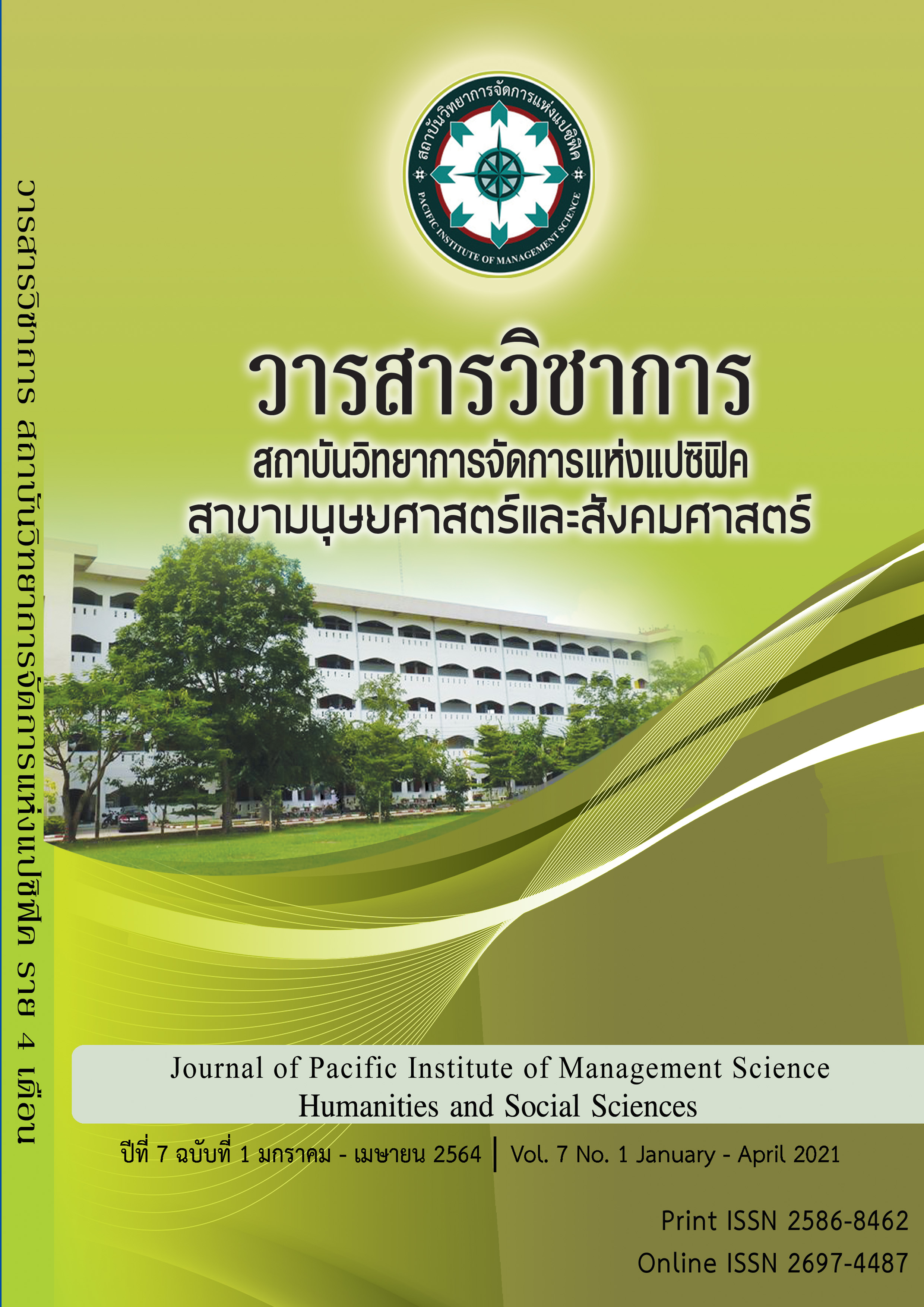การพัฒนาประสิทธิภาพการเก็บกู้วัตถุระเบิด ของสำนักงานตำรวจแห่งชาติ กรณีศึกษากลุ่มงานเก็บกู้และตรวจพิสูจน์วัตถุระเบิด กองบังคับการสายตรวจและปฏิบัติการพิเศษ กองบัญชาการตำรวจนครบาล สำนักงานตำรวจแห่งชาติ
คำสำคัญ:
การพัฒนาประสิทธิภาพ, การเก็บกู้วัตถุระเบิดบทคัดย่อ
การวิจัยครั้งนี้มีวัตถุประสงค์เพื่อ (1) เพื่อศึกษามาตรการเก็บกู้วัตถุระเบิด ของสำนักงานตำรวจแห่งชาติ (2) เพื่อศึกษาประสิทธิภาพมาตรการเก็บกู้วัตถุระเบิด ของสำนักงานตำรวจแห่งชาติ (3) เพื่อพัฒนาประสิทธิภาพการเก็บกู้วัตถุระเบิด ของสำนักงานตำรวจแห่งชาติ โดยมีกลุ่มตัวอย่างเป็น เจ้าหน้าที่ตำรวจเก็บกู้ทำลายวัตถุระเบิด ที่อยู่ในตำแหน่งเจ้าหน้าที่เก็บกู้และทำลายวัตถุระเบิด ของสำนักงานตำรวจแห่งชาติ จำนวน 267 คน แบ่งการศึกษาเป็น 2 ส่วน ส่วนที่ 1 เป็นการศึกษาและวิเคราะห์ประสิทธิภาพการเก็บกู้วัตถุระเบิดของเจ้าหน้าที่เก็บกู้และทำลายวัตถุระเบิด ของสำนักงานตำรวจแห่งชาติ ซึ่งเก็บข้อมูลโดยใช้แบบสอบถามกับเจ้าหน้าที่เก็บกู้และทำลายวัตถุระเบิด ของสำนักงานตำรวจแห่งชาติ มาตราส่วนประมาณค่า 5 ระดับ สถิติที่ใช้ได้แก่ สถิติเชิงพรรณนา (descriptive statistics) ในการวิเคราะห์ข้อมูลทั่วไปของกลุ่มตัวอย่าง หาความสัมพันธ์ การทดสอบความแตกต่างของค่าเฉลี่ย ใช้ t-test Dependent , F – test , One Way ANOVA , และการวิเคราะห์สหสัมพันธ์ (correlation analysis) ส่วนที่ 2 เป็นการศึกษาแนวทางการพัฒนาประสิทธิภาพของเจ้าหน้าที่เก็บกู้และทำลายวัตถุระเบิด ของสำนักงานตำรวจแห่งชาติ ซึ่งในการเก็บข้อมูลใช้การสนทนากลุ่มเจ้าหน้าที่เก็บกู้และทำลายวัตถุระเบิด กลุ่มงานเก็บกู้และตรวจพิสูจน์วัตถุระเบิด กองบังคับการสายตรวจและปฏิบัติการพิเศษ กองบัญชาการตำรวจนครบาล สำนักงานตำรวจแห่งชาติ และการสัมภาษณ์เชิงลึก ผู้บังคับบัญชาระดับสูง ของสำนักงานตำรวจแห่งชาติ จำนวน 2 คน
ผลการศึกษาพบว่า 1) การพัฒนาประสิทธิภาพของเจ้าหน้าที่เก็บกู้และทำลายวัตถุระเบิด มีระดับความคิดเห็นต่อการพัฒนาประสิทธิภาพของเจ้าหน้าที่เก็บกู้และทำลายวัตถุระเบิด ในประสิทธิภาพที่มีในปัจจุบัน ด้านบุคลากร มีความสัมพันธ์กับ ในประสิทธิภาพที่คาดหวังอย่างมีนัยสำคัญทางสถิติที่ระดับ 0.01 2) ได้แนวทางการพัฒนาประสิทธิภาพการเก็บกู้วัตถุระเบิดของสำนัก งานตำรวจแห่งชาติ ประกอบไปด้วย 3 ด้าน คือ (1) ด้านบุคลากร คือ การพัฒนาด้านฝึกอบรมทบทวนการเก็บกู้วัตถุระเบิดอย่างต่อเนื่อง (2) ด้านทักษะในการปฏิบัติงานการเก็บกู้วัตถุระเบิด คือ การพัฒนาทักษะการใช้เครื่องมือการเก็บกู้วัตถุระเบิดและการศึกษาบทเรียนการวางวัตถุระเบิด การเก็บกู้วัตถุระเบิด ของผู้ก่อการร้ายทั่วโลก (3) ด้านเทคโนโลยีในการเก็บกู้วัตถุระเบิด คือ การใช้เทคโนโลยีเข้ามาช่วยในการเก็บกู้วัตถุระเบิด เครื่องมือการพิสูจน์ทราบวัตถุระเบิดที่นำมาใช้ในการทำวัตถุระเบิดและเครื่องป้องกันอันตรายจากสารเคมีชีวะ กัมมันตรังสี ต่างๆ
เอกสารอ้างอิง
จงรักษ์ มีอุสาห์. (2551). แนวทางการพัฒนาประสิทธิภาพการปฏิบัติงานของบุคลากรองค์การบริหารส่วนจังหวัดกำแพงเพชร. วิทยานิพนธ์ปริญญามหาบัณฑิต. สาขารัฐประศาสนศาสตร์. มหาวิทยาลัยราชภัฎกำแพงเพชร.
ธงชัย สันติวงษ์.(2540 : 196). องค์การและการจัดการทันสมัยยุคโลกาภิวัตน์. กรุงเทพมหานคร : ไทยวัฒนาพานิช.
พจนกร กัญจินะ (2557) การประเมินผลการฝึกอบรมหลักสูตรการทำลายวัตถุระเบิดของกองสรรพาวุธ.สำนักงานตำรวจแห่งชาติ : มหาวิทยาลัยเชียงใหม่
พรพิมล รวีวงศ์ไพบูรณ์. (2553). ความต้องการการพัฒนาทรัพยากรมนุษย์ของพนักงาน บริษัท ไออาร์พีซี จำกัด (มหาชน) ส่วนสำนักงานกรุงเทพฯ. วิทยานิพนธ์ปริญญามหาบัณฑิต. สาขาวิชาบริหารการศึกษา. มหาวิทยาลัยรามคำแหง.
ระพิน ชาติไทย (2548 ) ความคิดเห็นของข้าราชการตำรวจกองสรรพาวุธต่อการปฏิบัติงานเก็บกู้วัตถุระเบิดมหาวิทยาลัยเกษตรศาสตร์. กรุงเทพมหานคร. มหาวิทยาลัยเกษตรศาสตร์
วิจิตร อาวะกุล (2540) การฝึกอบรม. กรุงเทพฯ. จุฬาลงกรณ์มหาวิทยาลัย.
ศูนย์ข้อมูลวัตถุระเบิด (2559). สถิติการก่อเหตุการณ์ที่ใช้วัตถุระเบิดในประเทศไทย .กองบังคับการตำรวจพิสูจน์หลักฐาน กองบัญชาการตำรวจพิสูจน์หลักฐาน สำนักงานตำรวจแห่งชาติ.
Peterson, Elmore and E. Grosvenor Plowaman.(1953). Business Organization and Management. Homewood, III. : Richard D. Irwin.
Taro Yamane.(1973).Statistics: An Introductory Analysis.3rdEd.New York.Harper and Row Publications.
ดาวน์โหลด
เผยแพร่แล้ว
ฉบับ
ประเภทบทความ
สัญญาอนุญาต
บทความที่ได้รับการตีพิมพ์เป็นลิขสิทธิ์ของ สถาบันวิทยาการจัดการแห่งแปซิฟิค
ข้อความที่ปรากฏในบทความแต่ละเรื่องในวารสารวิชาการเล่มนี้เป็นความคิดเห็นส่วนตัวของผู้เขียนแต่ละท่านไม่เกี่ยวข้องกับสถาบันวิทยาการจัดการแห่งแปซิฟิค และคณาจารย์ท่านอื่นๆในสถาบันฯ แต่อย่างใด ความรับผิดชอบองค์ประกอบทั้งหมดของบทความแต่ละเรื่องเป็นของผู้เขียนแต่ละท่าน หากมีความผิดพลาดใดๆ ผู้เขียนแต่ละท่านจะรับผิดชอบบทความของตนเองแต่ผู้เดียว







